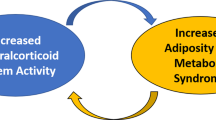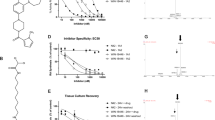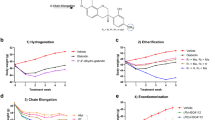Abstract
The magnitude of the obesity and metabolic syndrome epidemic has heightened the need for the development of new and effective treatments. Although circulating cortisol concentrations are not elevated in obesity or in the metabolic syndrome, decreasing the tissue-specific generation of cortisol through inhibition of 11β-hydroxysteroid dehydrogenase type 1 (11β-HSD1) has been postulated as a therapeutic strategy. Observations in cohorts of obese patients, in comparison with those with type 2 diabetes, have suggested that the ability to decrease tissue-specific cortisol production might represent a protective mechanism to improve insulin sensitivity and prevent diabetes. In rodents, pharmacologic exploitation of this mechanism, through the development of inhibitors selective for 11β-HSD1 (in preference to the type 2 isoform), dramatically improves insulin sensitivity. Here we review the published data and the rationale for treatment in humans, as well as discussing potential problems and adverse effects of future selective 11β-HSD1 inhibitors.
Key Points
-
Isoenzymes of 11β-hydroxysteroid dehydrogenase (11β-HSD) are tissue-specific regulators of cortisol metabolism
-
Nonselective 11β-HSD inhibitors cannot be used therapeutically because of systemic effects
-
Selective 11β-HSD1 inhibitors are effective in improving insulin sensitivity in rodents
-
Clinical trials are needed to test 11β-HSD1 inhibitors as therapy for type 2 diabetes and the metabolic syndrome
This is a preview of subscription content, access via your institution
Access options
Subscribe to this journal
Receive 12 print issues and online access
$209.00 per year
only $17.42 per issue
Buy this article
- Purchase on Springer Link
- Instant access to full article PDF
Prices may be subject to local taxes which are calculated during checkout


Similar content being viewed by others
References
World Health Organization [http://www.who.int/en/]
Calle EE et al. (1999) Body-mass index and mortality in a prospective cohort of US adults. N Engl J Med 341: 1097–1105
Hebert PR et al. (1997) Cholesterol lowering with statin drugs, risk of stroke, and total mortality. An overview of randomized trials. JAMA 278: 313–321
Li Z et al. (2005) Meta-analysis: pharmacologic treatment of obesity. Ann Intern Med 142: 532–546
Van Gaal LF et al. (2005) Effects of the cannabinoid-1 receptor blocker rimonabant on weight reduction and cardiovascular risk factors in overweight patients: 1-year experience from the RIO-Europe study. Lancet 365: 1389–1397
Batterham RL et al. (2003) Inhibition of food intake in obese subjects by peptide YY3-36. N Engl J Med 349: 941–948
Fraser R et al. (1999) Cortisol effects on body mass, blood pressure, and cholesterol in the general population. Hypertension 33: 1364–1368
White PC et al. (1997) 11β-hydroxysteroid dehydrogenase and the syndrome of apparent mineralocorticoid excess. Endocr Rev 18: 135–156
Odermatt A et al. (1999) The N-terminal anchor sequences of 11β-hydroxysteroid dehydrogenases determine their orientation in the endoplasmic reticulum membrane. J Biol Chem 274: 28762–28770
Agarwal AK et al. (1990) Expression of 11β-hydroxysteroid dehydrogenase using recombinant vaccinia virus. Mol Endocrinol 4: 1827–1832
Kotelevtsev Y et al. (1997) 11β-hydroxysteroid dehydrogenase type 1 knockout mice show attenuated glucocorticoid-inducible responses and resist hyperglycemia on obesity or stress. Proc Natl Acad Sci USA 94: 14924–14929
Bujalska IJ et al. (2002) A switch in dehydrogenase to reductase activity of 11β-hydroxysteroid dehydrogenase type 1 upon differentiation of human omental adipose stromal cells. J Clin Endocrinol Metab 87: 1205–1210
Masuzaki H et al. (2001) A transgenic model of visceral obesity and the metabolic syndrome. Science 294: 2166–2170
Bujalska IJ et al. (1997) Does central obesity reflect “Cushing's disease of the omentum”? Lancet 349: 1210–1213
Stewart PM et al. (1999) Cortisol metabolism in human obesity: impaired cortisone–cortisol conversion in subjects with central adiposity. J Clin Endocrinol Metab 84: 1022–1027
Rask E et al. (2001) Tissue-specific dysregulation of cortisol metabolism in human obesity. J Clin Endocrinol Metab 86: 1418–1421
Rask E et al. (2002) Tissue-specific changes in peripheral cortisol metabolism in obese women: increased adipose 11β-hydroxysteroid dehydrogenase type 1 activity. J Clin Endocrinol Metab 87: 3330–3336
Valsamakis G et al. (2004) 11β-hydroxysteroid dehydrogenase type 1 activity in lean and obese males with type 2 diabetes mellitus. J Clin Endocrinol Metab 89: 4755–4761
Westerbacka J et al. (2003) Body fat distribution and cortisol metabolism in healthy men: enhanced 5β-reductase and lower cortisol/cortisone metabolite ratios in men with fatty liver. J Clin Endocrinol Metab 88: 4924–4931
Sandeep TC et al. (2005) Increased in vivo regeneration of cortisol in adipose tissue in human obesity and effects of the 11β-hydroxysteroid dehydrogenase type 1 inhibitor carbenoxolone. Diabetes 54: 872–879
Tomlinson JW et al. (2002) Expression of 11β-hydroxysteroid dehydrogenase type 1 in adipose tissue is not increased in human obesity. J Clin Endocrinol Metab 87: 5630–5635
Wake DJ et al. (2003) Local and systemic impact of transcriptional up-regulation of 11β-hydroxysteroid dehydrogenase type 1 in adipose tissue in human obesity. J Clin Endocrinol Metab 88: 3983–3988
Paulmyer-Lacroix O et al. (2002) Expression of the mRNA coding for 11β-hydroxysteroid dehydrogenase type 1 in adipose tissue from obese patients: an in situ hybridization study. J Clin Endocrinol Metab 87: 2701–2705
Lindsay RS et al. (2003) Subcutaneous adipose 11β-hydroxysteroid dehydrogenase type 1 activity and messenger ribonucleic acid levels are associated with adiposity and insulinemia in Pima Indians and Caucasians. J Clin Endocrinol Metab 88: 2738–2744
Kannisto K et al. (2004) Overexpression of 11β-hydroxysteroid dehydrogenase-1 in adipose tissue is associated with acquired obesity and features of insulin resistance: studies in young adult monozygotic twins. J Clin Endocrinol Metab 89: 4414–4421
Drake AJ et al. (2005) Reduced adipose glucocorticoid reactivation and increased hepatic glucocorticoid clearance as an early adaptation to high-fat feeding in Wistar rats. Endocrinology 146: 913–919
Morton NM et al. (2004) Down-regulation of adipose 11β-hydroxysteroid dehydrogenase type 1 by high-fat feeding in mice: a potential adaptive mechanism counteracting metabolic disease. Endocrinology 145: 2707–2712
Liu Y et al. (2003) Leptin activation of corticosterone production in hepatocytes may contribute to the reversal of obesity and hyperglycemia in leptin-deficient ob/ob mice. Diabetes 52: 1409–1416
Andrew R et al. (2002) Distinguishing the activities of 11β-hydroxysteroid dehydrogenases in vivo using isotopically labeled cortisol. J Clin Endocrinol Metab 87: 277–285
Basu R et al. (2004) Splanchnic cortisol production occurs in humans: evidence for conversion of cortisone to cortisol via the 11-β hydroxysteroid dehydrogenase (11beta-hsd) type 1 pathway. Diabetes 53: 2051–2059
Andrew R et al. (2005) The contribution of visceral adipose tissue to splanchnic cortisol production in healthy humans. Diabetes 54: 1364–1370
Basu R et al. (2005) Obesity and type 2 diabetes do not alter splanchnic cortisol production in humans. J Clin Endocrinol Metab 90: 3919–3926
Kerstens MN et al. (2000) Lack of relationship between 11β-hydroxysteroid dehydrogenase setpoint and insulin sensitivity in the basal state and after 24 h of insulin infusion in healthy subjects and type 2 diabetic patients. Clin Endocrinol (Oxf) 52: 403–411
Diederich S et al. (2000) In the search for specific inhibitors of human 11β-hydroxysteroid-dehydrogenases (11β-HSDs): chenodeoxycholic acid selectively inhibits 11β-HSD-I. Eur J Endocrinol 142: 200–207
Yang K and Yu M (1994) Evidence for distinct isoforms of 11β-hydroxysteroid dehydrogenase in the ovine liver and kidney. J Steroid Biochem Mol Biol 49: 245–250
Walker BR et al. (1995) Carbenoxolone increases hepatic insulin sensitivity in man: a novel role for 11-oxosteroid reductase in enhancing glucocorticoid receptor activation. J Clin Endocrinol Metab 80: 3155–3159
Andrews RC et al. (2003) Effects of the 11 β-hydroxysteroid dehydrogenase inhibitor carbenoxolone on insulin sensitivity in men with type 2 diabetes. J Clin Endocrinol Metab 88: 285–291
Maser E and Bannenberg G (1994) 11β-hydroxysteroid dehydrogenase mediates reductive metabolism of xenobiotic carbonyl compounds. Biochem Pharmacol 47: 1805–1812
Szotakova B et al. (2000) Reduction of the potential anticancer drug oracin in the rat liver in-vitro. J Pharm Pharmacol 52: 495–500
Hult M et al. (2001) Novel enzymological profiles of human 11β-hydroxysteroid dehydrogenase type 1. Chem Biol Interact 130–132: 805–814
Oppermann UC and Maser E (2000) Molecular and structural aspects of xenobiotic carbonyl metabolizing enzymes. Role of reductases and dehydrogenases in xenobiotic phase I reactions. Toxicology 144: 71–81
Bannenberg G et al. (2003) 11β-hydroxysteroid dehydrogenase type 1: tissue-specific expression and reductive metabolism of some anti-insect agent azole analogues of metyrapone. Chem Biol Interact 143–144: 449–457
Maser E (1998) 11β-hydroxysteroid dehydrogenase responsible for carbonyl reduction of the tobacco-specific nitrosamine 4-(methylnitrosamino)-1-(3-pyridyl)-1-butanone in mouse lung microsomes. Cancer Res 58: 2996–3003
Finckh C et al. (2001) Expression and NNK reducing activities of carbonyl reductase and 11β-hydroxysteroid dehydrogenase type 1 in human lung. Chem Biol Interact 130–132: 761–773
Monder C and White PC (1993) 11β-hydroxysteroid dehydrogenase. Vitam Horm 47: 187–271
Morris DJ et al. (2004) Effect of chenodeoxycholic acid on 11β-hydroxysteroid dehydrogenase in various target tissues. Metabolism 53: 811–816
Shimoyama Y et al. (2003) Effects of glycyrrhetinic acid derivatives on hepatic and renal 11β-hydroxysteroid dehydrogenase activities in rats. J Pharm Pharmacol 55: 811–817
Hult M et al. (1998) Selective inhibition of human type 1 11β-hydroxysteroid dehydrogenase by synthetic steroids and xenobiotics. FEBS Lett 441: 25–28
Schweizer RA et al. (2003) A rapid screening assay for inhibitors of 11β-hydroxysteroid dehydrogenases (11beta-HSD): flavanone selectively inhibits 11β-HSD1 reductase activity. Mol Cell Endocrinol 212: 41–49
Thieringer R et al. (2004) A novel non-steroidal inhibitor of 11β-hydroxysteroid dehydrogenase type 1 improves features of metabolic syndrome in murine disease models [abstract]. Endocr Abstr 7: P47
Barf T et al. (2002) Arylsulfonamidothiazoles as a new class of potential antidiabetic drugs. Discovery of potent and selective inhibitors of the 11β-hydroxysteroid dehydrogenase type 1. J Med Chem 45: 3813–3815
Koch MA et al. (2004) Compound library development guided by protein structure similarity clustering and natural product structure. Proc Natl Acad Sci USA 101: 16721–16726
Alberts P et al. (2002) Selective inhibition of 11β-hydroxysteroid dehydrogenase type 1 decreases blood glucose concentrations in hyperglycemic mice. Diabetologia 45: 1528–1532
Alberts P et al. (2003) Selective inhibition of 11β-hydroxysteroid dehydrogenase type 1 improves hepatic insulin sensitivity in hyperglycemic mice strains. Endocrinology 144: 4755–4762
Davani B et al. (2000) Type 1 11β-hydroxysteroid dehydrogenase mediates glucocorticoid activation and insulin release in pancreatic islets. J Biol Chem 275: 34841–34844
Davani B et al. (2004) Aged transgenic mice with increased glucocorticoid sensitivity in pancreatic β-cells develop diabetes. Diabetes 53 (Suppl 1): S51–S59
Draper N et al. (2003) Mutations in the genes encoding 11β-hydroxysteroid dehydrogenase type 1 and hexose-6-phosphate dehydrogenase interact to cause cortisone reductase deficiency. Nat Genet 34: 434–439
Jamieson PM et al. (1995) 11β-hydroxysteroid dehydrogenase is an exclusive 11β- reductase in primary cultures of rat hepatocytes: effect of physicochemical and hormonal manipulations. Endocrinology 136: 4754–4761
Tomlinson JW et al. (2004) 11β-hydroxysteroid dehydrogenase type 1: a tissue-specific regulator of glucocorticoid response. Endocr Rev 25: 831–866
Bujalska IJ et al. (2005) Hexose-6-phosphate dehydrogenase confers oxo-reductase activity upon 11β-hydroxysteroid dehydrogenase type 1. J Mol Endocrinol 34: 675–684
Atanasov AG et al. (2004) Hexose-6-phosphate dehydrogenase determines the reaction direction of 11β-hydroxysteroid dehydrogenase type 1 as an oxoreductase. FEBS Lett 571: 129–133
Banhegyi G et al. (2004) Cooperativity between 11β-hydroxysteroid dehydrogenase type 1 and hexose-6-phosphate dehydrogenase in the lumen of the endoplasmic reticulum. J Biol Chem 279: 27017–27021
Cooper MS et al. (2000) Expression and functional consequences of 11β-hydroxysteroid dehydrogenase activity in human bone. Bone 27: 375–381
Stokes J et al. (2000) Distribution of glucocorticoid and mineralocorticoid receptors and 11β-hydroxysteroid dehydrogenases in human and rat ocular tissues. Invest Ophthalmol Vis Sci 41: 1629–1638
Rauz S et al. (2001) Expression and putative role of 11β-hydroxysteroid dehydrogenase isozymes within the human eye. Invest Ophthalmol Vis Sci 42: 2037–2042
Sandeep TC et al. (2004) 11β-hydroxysteroid dehydrogenase inhibition improves cognitive function in healthy elderly men and type 2 diabetics. Proc Natl Acad Sci USA 101: 6734–6739
Rauz S et al. (2003) Inhibition of 11β-hydroxysteroid dehydrogenase type 1 lowers intraocular pressure in patients with ocular hypertension. QJM 96: 481–490
Yau JL et al. (2001) Lack of tissue glucocorticoid reactivation in 11β-hydroxysteroid dehydrogenase type 1 knockout mice ameliorates age-related learning impairments. Proc Natl Acad Sci USA 98: 4716–4721
Author information
Authors and Affiliations
Corresponding author
Ethics declarations
Competing interests
The authors declare no competing financial interests.
Rights and permissions
About this article
Cite this article
Tomlinson, J., Stewart, P. Mechanisms of Disease: selective inhibition of 11β-hydroxysteroid dehydrogenase type 1 as a novel treatment for the metabolic syndrome. Nat Rev Endocrinol 1, 92–99 (2005). https://doi.org/10.1038/ncpendmet0023
Received:
Accepted:
Issue Date:
DOI: https://doi.org/10.1038/ncpendmet0023
This article is cited by
-
Development and structure–activity relationships of tanshinones as selective 11β-hydroxysteroid dehydrogenase 1 inhibitors
Natural Products and Bioprospecting (2022)
-
Interaction of HSD11B1 and H6PD polymorphisms in subjects with type 2 diabetes are protective factors against obesity: a cross-sectional study
Diabetology & Metabolic Syndrome (2019)
-
Enhanced hexose-6-phosphate dehydrogenase expression in adipose tissue may contribute to diet-induced visceral adiposity
International Journal of Obesity (2018)
-
Expression of cortisol metabolism-related genes shows circadian rhythmic patterns in human adipose tissue
International Journal of Obesity (2009)



